by Larry Williams | Apr 13, 2017
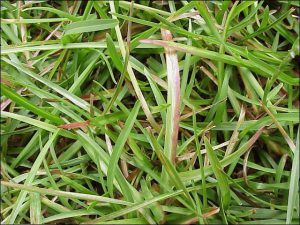
Spittlebug damage on centipedegrass. Photo credit: Larry Williams UF/IFAS
Mole crickets, chinch bugs and spittlebugs are common lawn insect pests to begin watching for this time of year.
Mole crickets can be active in lawns spring through fall, but the best window of opportunity to control them is in June and July.
Soap flushing is a technique to survey for mole crickets. Mix two ounces of liquid dishwashing soap in two gallons of water and apply with a sprinkling can to four square feet of turf in several areas where mole crickets are suspected. If an average of two to four mole crickets appear on the surface within several minutes, then a treatment is probably needed.
Chinch bugs only damage St. Augustinegrass. So if your lawngrass is something other than St. Augustine, don’t worry about this insect.
Damage from chinch bugs tends to begin in April. However, they are more likely to be active during warmer summer months through early fall in the more sunny areas of the yard, particularly if it’s dry.
Inspect a St. Augustinegrass lawn weekly during spring, summer and fall. Look for areas that quickly turn yellow and then straw brown. Part the grass at the margin of the yellowed areas and closely examine the soil surface and base of the turf for tiny insects. Immature chinch bugs are pink to red and are about the size of a pinhead. The adults are only 1/8 inch long and black with white wings.
Spittlebugs attack all turfgrass species but centipedegrass is their favorite. The first generation of adult spittlebugs is abundant in June and the peak population usually occurs in August to early September.
An early sign of spittlebug activity are masses of white, frothy spittle found in the turf. Each piece of spittle contains one immature spittle bug. Infested turf turns yellow and eventually brown. Damage resembles chinch bug injury but usually first appears in shady areas. Closer inspection reveals discolored individual grass blades with cream colored and pinkish-purple streaks running the length of individual blades. As the population builds, the ¼ inch long adults are abundant. As you walk through or mow an infested area, numerous adult spittlebugs fly short distances when disturbed. Adults are black with two orange transverse stripes across their wings.
Correct lawn management can minimize many pest problems. If a pesticide becomes necessary to control a lawn pest, be sure to follow the product’s label instructions and precautions.
by Carrie Stevenson | Apr 7, 2017
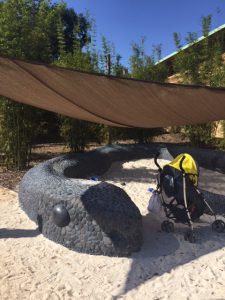
This sandbox area at Bok Tower Gardens is bordered by a stone “snake” and covered for shade, making it a real draw for small children and their parents. Photo credit: Carrie Stevenson, UF IFAS Extension
I recently had the pleasure of visiting Bok Tower Gardens in Lake Wales, Florida and experienced one of their newest additions, a children’s garden. As much a playground as a place for growing plants, it was full of whimsical energy and invitations to explore. The entire area encouraged children to reach beyond their comfort zones and engage with nature, including an outdoor art space, a climbing area made of lean-to logs, and a covered sand “box” shaped like a snake.
In recent years, sociologists, educators, and health experts have bemoaned the loss of free outdoor play in the lives of children. Multiple factors, including the rise in electronic entertainment, more organized, practice-heavy youth sports, fears of crime/abduction or just lack of safe access to ride bikes or walk, have contributed to a drop in the frequency and length of time that kids spend outdoors playing on their own. Many readers can probably relate to my childhood. We would take off on bikes in the mornings during summer and not come back until we got hungry. We didn’t have cell phones or GPS, and we knew all of our neighbors so we had a place to go if we had a rare emergency. The results of fewer child-led outdoor explorations include increases in childhood obesity, fear of the outdoors, difficulty with balance, agility, and managing excess energy.
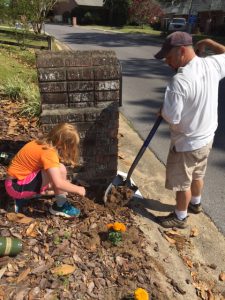
When children help plant a garden, they will be more interested in taking care of it–and tasting the fruits (or vegetables) of their labor! Photo credit: Carrie Stevenson, UF IFAS Extension
One way to encourage kids to get outside and explore is to plant something in your yard, school, or nearby park that can serve double-duty as a window to explore. Landscaping with young people in mind should include a variety of plants with interesting heights and textures, fruit-bearing shrubs or trees to engage the sense of taste, and lots of color. Logs to sit and climb on are perfect for developing balance and learning to take calculated risks. In addition, it is important to engage kids in the design and planting of the garden or landscape–if they have a hand in developing the area, they’ll be more invested in its success. In fact, research has consistently shown that children who help care for school gardens are more willing to try the food they’ve helped to grow. Beyond expanding a healthy palate, participation in school gardens can increase “soft” skills, such as the ability to work effectively in a team, better communication, and an increased appreciation for nature. Many kids also do better in science and gain a deeper understanding of proper nutrition after working with gardens.
If you are not a gardener or landscaper but interested in taking children outdoors where they can learn and become more comfortable, the US Forest Service has taken the research related to “nature-deficit disorder” so seriously that multiple “Children’s Forests” have been developed. While there are still very few in the southeastern US, there are dozens around the country. The stated goals for a Children’s Forest are: 1) Connect kids, families, and adults to healthy outdoor activities across all landscapes. 2) Create new education and career opportunities. 3) Foster an understanding of how our changing environment affects the world and how people can work together to embrace these changes. 4) Provide professional development opportunities for educators, with emphasis on conservation and the natural world. Local state and national parks often provide excellent programs for families as well, such as the National Park System’s Junior Ranger Program.
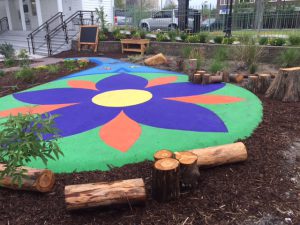
The landscaping at this coffee shop uses color, log seating/climbing, and a variety of interesting plants to attract children to engage with the outdoors.
A program in Gainesville called “Kids in the Woods” has recognized the lack of youth engagement in the outdoors and created field trips and curriculum for students designed to help make sure they are comfortable in the great outdoors. No matter how you engage the youth in your life with nature, it is important that they get outside, get dirty, and go beyond their comfort zone. Their health, academic success, and even motor skills needed for sports and daily life will reap the benefits!
by Matt Lollar | Apr 7, 2017
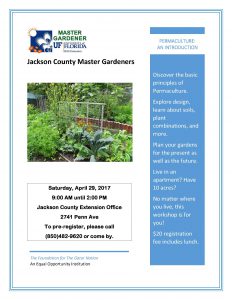
The Jackson County Master Gardeners are hosting “Permaculture: An Introduction” on Saturday, April 29. Join us from 9AM to 2PM on Saturday, April 29 at the Jackson County Extension Office (2741 Penn Ave., Ste.#3, Marianna, FL) to learn the basics of permaculture. What is permaculture you might ask? Basically, it is the utilization of edible plants in your landscape to create a food forest. The workshop is $20 and includes lunch. To register or for more details please contact Matt Lollar at mlollar@ufl.edu, (850)482-9620, or come by the Jackson County Extension Office.
by Molly Jameson | Apr 7, 2017
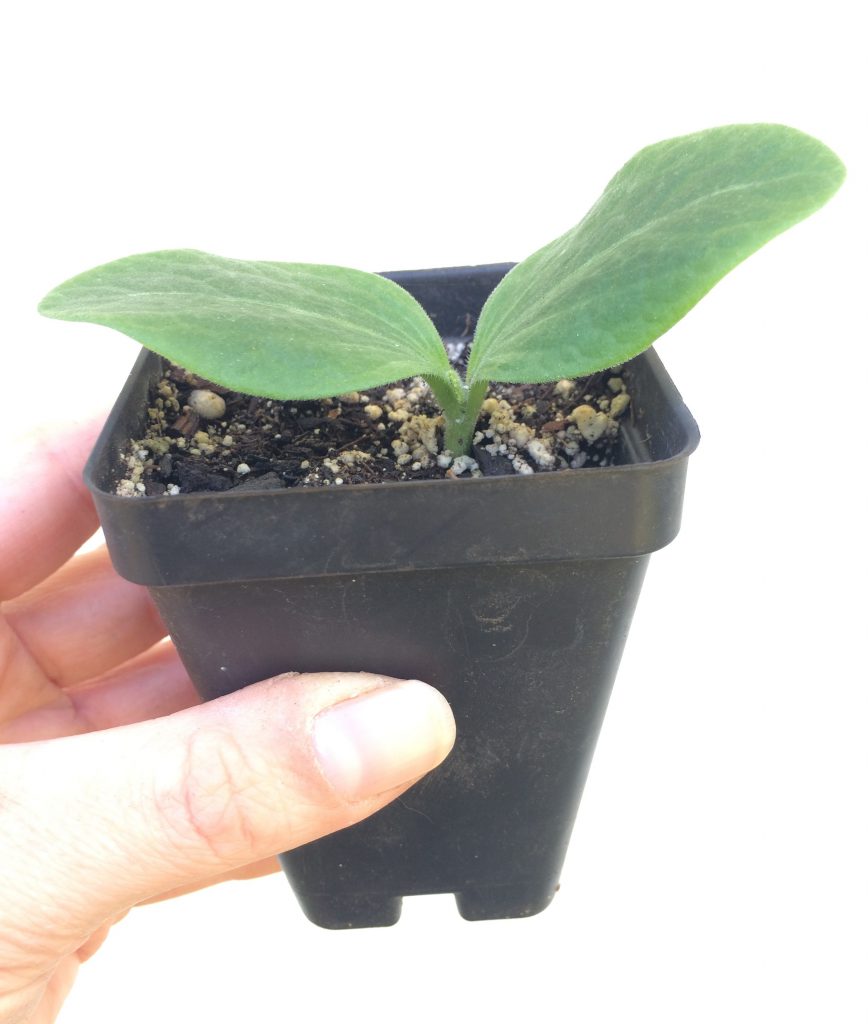
Be careful planting cucurbit transplants, as they have sensitive roots. Photo by Molly Jameson.
When I think of the end of winter and the hot temperatures that will soon be here to stay in the Florida Panhandle, I often feel a little melancholy. But the one silver lining that always picks me back up is remembering what warmer temperatures will mean in the garden. This is the start to all the fun, colorful, fruiting crops. Think of the oranges, reds, yellows, and even purples that will soon fill their vines.
As an extension agent, one of the questions I am often asked is whether to start summer vegetables from seed directly in the garden, or to start seeds in pots and transplant them later. The answer is – as is often the case – it depends.
Are you planting tomatoes, peppers, or eggplant? Well, the beginning of April is too late to start from seeds with these crops in our neck of the woods. Buy transplants! Are you growing beans, okra, or root crops? Now that we are past the risk of frost, put those seeds directly into your garden. Are you growing cucurbits, like squash, cucumbers, or melons? You have a choice. You could seed them directly, or you could start seeds in pots. What is the advantage of starting in pots, you ask? Well – this will give you the chance to pick the strongest plants and will allow you to transplant them exactly where you want them. The disadvantage? Other than the extra work, cucurbits tend to be sensitive to disturbance. Be sure to handle with care and do not over water once your seedlings have sprouted.
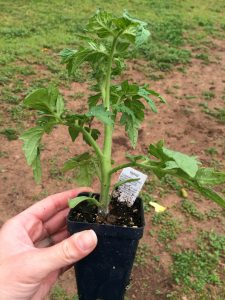
Transplant into the garden when the plant is about the length of its pot. Photo by Molly Jameson.
Whether you grew the seeds in pots yourself or acquired transplants elsewhere, there are certain practices you can follow to ensure your plant babies have a good start. Here are a few tips when it comes to transplanting into the garden:
What should be considered when purchasing transplants? When purchasing transplants, it is important to make sure the plant is healthy. Look for plants with strong stems, green leaves, and no signs of pest or disease damage. Ideally, the plant should not be much taller than the length of its pot, and should be about as tall as it is wide. Also, avoid vegetable plants that are already producing fruit, this is an indication they have been in their pot too long, prompting them to become stressed. When stressed, annuals often feel they need to hurry and produce seeds to carry on the next generation.
When should transplants be planted into the garden? For spring gardens, plant transplants once danger of frost has passed (late March in the Panhandle), when the transplant has had time to develop a strong root system, and when the transplant is about the length of its pot. If you are growing your seeds indoors or in a greenhouse, allow the plant to “harden-off” by placing the plants outdoors in partial shade for a few hours a day for about a week before transplanting.
What is the transplanting process?
- First, prepare your garden site with compost and other soil amendments.
- Water your plants very thoroughly just before planting to decrease transplant shock. The entire root system should be completely wet.
- Dig a hole that is at least double the width of the plant’s root ball.
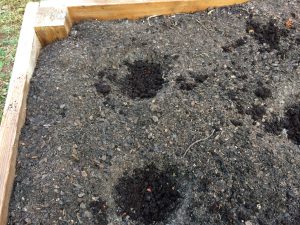
Add fresh compost or worm castings to each planting hole to give your plants an extra nutrient boost. Photo by Molly Jameson.
- Add one to two handfuls of fresh compost or worm castings to each hole. These soil amendments will improve soil health, introduce beneficial microbes, and provide a slow- release nutrient source for your growing seedlings.
- Avoid covering any leaves or stems under the soil surface. Remove these lower leaves and stems with sharp garden clippers to minimize the size of the wound.
- Avoid touching the stem and avoid disturbing the root ball when removing the transplant from its pot. Gently squeeze the pot to loosen the potting soil and turn the transplant sideways or upside down with the palm of your hand to gently “catch” the transplant.
- Unless the transplant is a tomato, plant it so that the soil level is about the soil level of the transplant, making sure the plant has good structure to decrease susceptibility of falling over as it grows.
- If transplanting a tomato, plant deeper than the soil level of the transplant, as tomatoes can grow what are called “adventitious” roots – roots that grow from their stem – that will improve overall root development.
- Make sure to cover up all roots, and water the soil around the plant thoroughly. Continue to water deeply, keeping the soil moist but not soggy, for the next three to four days while the plant becomes established. You can then begin to switch to a normal watering pattern.
- Always water the soil around the plant, not the plant leaves, throughout the season to decrease susceptibility to disease.
Remember: gardening is a science and an art! And just like art, there are many aspects that are open to interpretation. Have fun gardening – experiment and try new techniques. Keep a journal tracking all your gardening adventures. With time, this can become your road map to the sweetest of summer fruit.
by Julie McConnell | Apr 7, 2017
It’s really tempting to buy a tree and plant it in the middle of your lawn or directly in front of your picture window, but instead take some time to choose the best spot first. Several considerations such as maintenance and mature size should be taken into account before the site is selected.
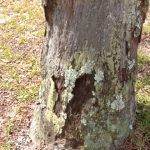
Mowing close to the trunk of this Pindo palm has caused repeated injury to the trunk. Photo: JMcConnell, UF/IFAS
Placing a tree in a lawn area without creating a bed can lead to maintenance issues for both the tree and the turfgrass. It is easy to simply cut out a small patch of turf the size of the rootball and install a tree, however, as the grass grows up towards the trunk over time maintaining that grass will become difficult. It is common to see mechanical injuries to tree trunks because weed eaters or mowers have chipped away at the bark when trying to cut the grass. Other potential problems are irrigation zones calibrated for turf delivering the wrong amount of water to trees and herbicides used on grass that may cause injury to trees.
Over time, as the tree canopy grows, it will create shade and any grass trying to grow in that area will thin and be more susceptible to disease and insect pressure. By creating a large ornamental bed for your tree, you will prevent some pitfalls associated with placing the tree in the lawn.
Another common mistake is planting a tree too close to a house or other structure. It can be difficult to imagine how large a tree will grow at maturity because it is not a quick process. Trees placed close to houses may grow into eaves and shed leaves onto roofs and into gutters. This adds to maintenance and can provide mosquito breeding grounds. Also, some tree roots may interfere with walkways or septic systems and should be sited far enough away to avoid these issues.
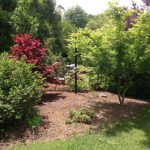
These Japanese Maples are planted in a bed separate from the lawn making care for both plant types easier. Photo: JMcConnell, UF/IFAS
Be sure to research any tree you plan to install to find out ideal growing conditions and mature size. If you plan ahead and use good maintenance practices, a tree can become an valuable part of your home landscape to be enjoyed for years to come.










